air condition Peugeot Boxer 2011.5 - RHD (UK, Australia) User Guide
[x] Cancel search | Manufacturer: PEUGEOT, Model Year: 2011.5, Model line: Boxer, Model: Peugeot Boxer 2011.5Pages: 184, PDF Size: 4.86 MB
Page 82 of 184
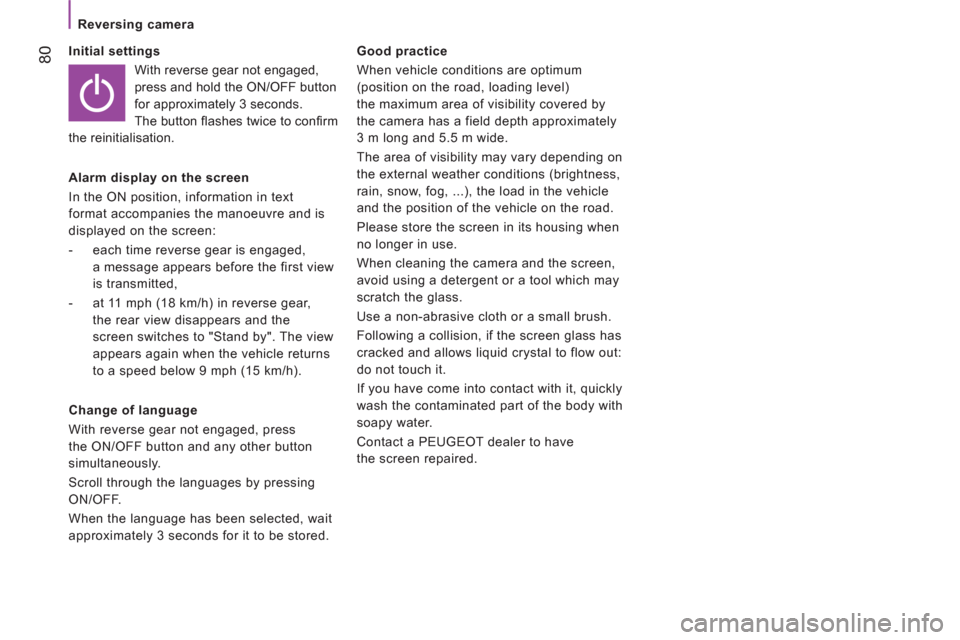
80
Reversing camera
Initial settings
With reverse gear not engaged,
press and hold the ON/OFF button
for approximately 3 seconds.
The button fl ashes twice to confi rm
the reinitialisation.
Alarm display on the screen
In the ON position, information in text
format accompanies the manoeuvre and is
displayed on the screen:
- each time reverse gear is engaged,
a message appears before the first view
is transmitted,
- at 11 mph (18 km/h) in reverse gear,
the rear view disappears and the
screen switches to "Stand by". The view
appears again when the vehicle returns
to a speed below 9 mph (15 km/h).
Change of language
With reverse gear not engaged, press
the ON/OFF button and any other button
simultaneously.
Scroll through the languages by pressing
ON/OFF.
When the language has been selected, wait
approximately 3 seconds for it to be stored.
Good practice
When vehicle conditions are optimum
(position on the road, loading level)
the maximum area of visibility covered by
the camera has a field depth approximately
3 m long and 5.5 m wide.
The area of visibility may vary depending on
the external weather conditions (brightness,
rain, snow, fog, ...), the load in the vehicle
and the position of the vehicle on the road.
Please store the screen in its housing when
no longer in use.
When cleaning the camera and the screen,
avoid using a detergent or a tool which may
scratch the glass.
Use a non-abrasive cloth or a small brush.
Following a collision, if the screen glass has
cracked and allows liquid crystal to flow out:
do not touch it.
If you have come into contact with it, quickly
wash the contaminated part of the body with
soapy water.
Contact a PEUGEOT dealer to have
the screen repaired.
Page 133 of 184
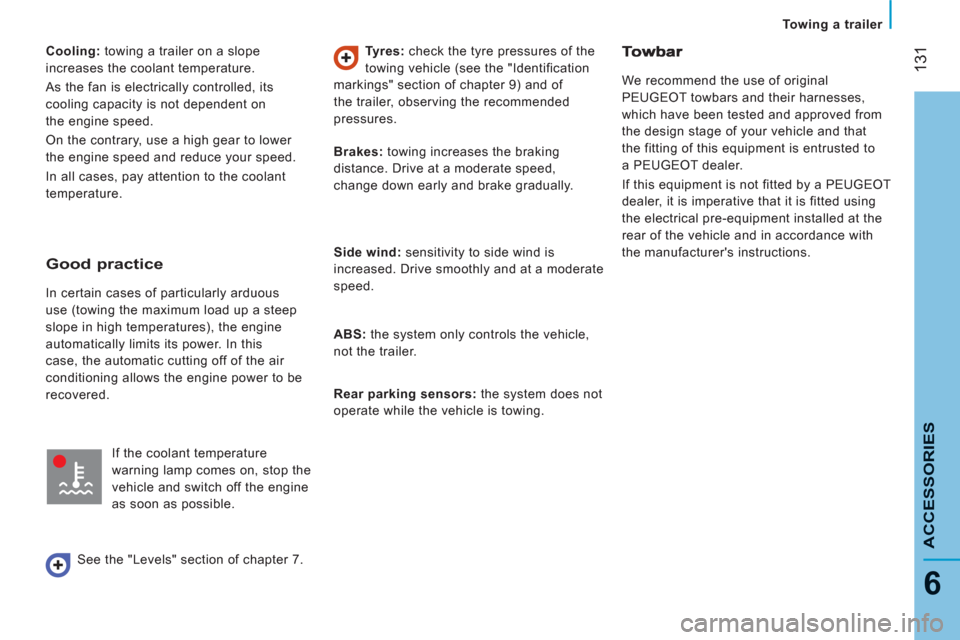
131
6
Towing a trailer
ACCESSORIE
S
Cooling:
towing a trailer on a slope
increases the coolant temperature.
As the fan is electrically controlled, its
cooling capacity is not dependent on
the engine speed.
On the contrary, use a high gear to lower
the engine speed and reduce your speed.
In all cases, pay attention to the coolant
temperature.
Tyres:
check the tyre pressures of the
towing vehicle (see the "Identification
markings" section of chapter 9) and of
the trailer, observing the recommended
pressures.
We recommend the use of original
PEUGEOT towbars and their harnesses,
which have been tested and approved from
the design stage of your vehicle and that
the fitting of this equipment is entrusted to
a PEUGEOT dealer.
If this equipment is not fitted by a PEUGEOT
dealer, it is imperative that it is fitted using
the electrical pre-equipment installed at the
rear of the vehicle and in accordance with
the manufacturer's instructions.
Good practice
In certain cases of particularly arduous
use (towing the maximum load up a steep
slope in high temperatures), the engine
automatically limits its power. In this
case, the automatic cutting off of the air
conditioning allows the engine power to be
recovered.
If the coolant temperature
warning lamp comes on, stop the
vehicle and switch off the engine
as soon as possible.
See the "Levels" section of chapter 7.
Brakes:
towing increases the braking
distance. Drive at a moderate speed,
change down early and brake gradually.
Side wind:
sensitivity to side wind is
increased. Drive smoothly and at a moderate
speed.
ABS:
the system only controls the vehicle,
not the trailer.
Rear parking
sensors
:
the system does not
operate while the vehicle is towing.
Page 140 of 184
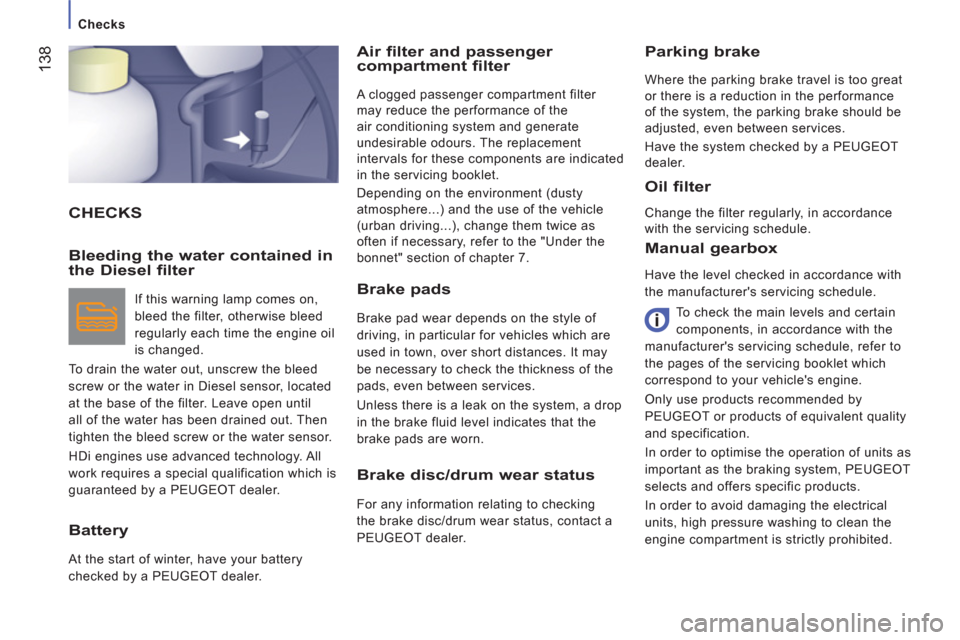
Checks
138
CHECKS
Air filter and passenger compartment filter
A clogged passenger compartment filter
may reduce the performance of the
air conditioning system and generate
undesirable odours. The replacement
intervals for these components are indicated
in the servicing booklet.
Depending on the environment (dusty
atmosphere...) and the use of the vehicle
(urban driving...), change them twice as
often if necessary, refer to the "Under the
bonnet" section of chapter 7.
Manual gearbox
Have the level checked in accordance with
the manufacturer's servicing schedule.
To check the main levels and certain
components, in accordance with the
manufacturer's servicing schedule, refer to
the pages of the servicing booklet which
correspond to your vehicle's engine.
Only use products recommended by
PEUGEOT or products of equivalent quality
and specification.
In order to optimise the operation of units as
important as the braking system, PEUGEOT
selects and offers specific products.
In order to avoid damaging the electrical
units, high pressure washing to clean the
engine compartment is strictly prohibited.
Parking brake
Where the parking brake travel is too great
or there is a reduction in the performance
of the system, the parking brake should be
adjusted, even between services.
Have the system checked by a PEUGEOT
dealer.
Bleeding the water contained in
the Diesel filter
If this warning lamp comes on,
bleed the filter, otherwise bleed
regularly each time the engine oil
is changed.
To drain the water out, unscrew the bleed
screw or the water in Diesel sensor, located
at the base of the filter. Leave open until
all of the water has been drained out. Then
tighten the bleed screw or the water sensor.
HDi engines use advanced technology. All
work requires a special qualification which is
guaranteed by a PEUGEOT dealer.
Battery
At the start of winter, have your battery
checked by a PEUGEOT dealer.
Brake pads
Brake pad wear depends on the style of
driving, in particular for vehicles which are
used in town, over short distances. It may
be necessary to check the thickness of the
pads, even between services.
Unless there is a leak on the system, a drop
in the brake fluid level indicates that the
brake pads are worn.
Brake disc/drum wear status
For any information relating to checking
the brake disc/drum wear status, contact a
PEUGEOT dealer.
Oil filter
Change the filter regularly, in accordance
with the servicing schedule.
Page 141 of 184
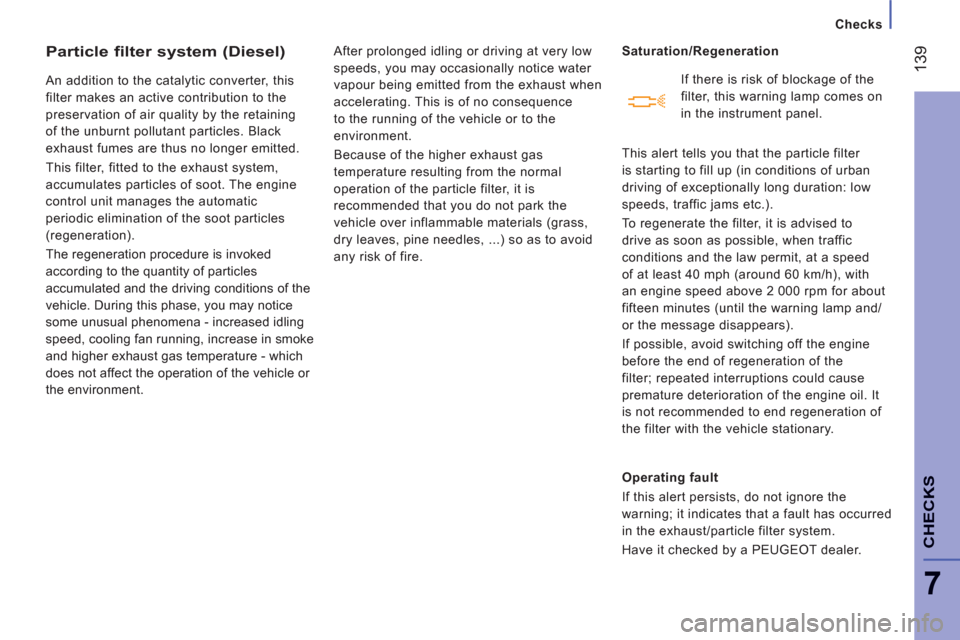
Checks
139
7
CHECK
S
Particle filter system (Diesel)
An addition to the catalytic converter, this
filter makes an active contribution to the
preservation of air quality by the retaining
of the unburnt pollutant particles. Black
exhaust fumes are thus no longer emitted.
This filter, fitted to the exhaust system,
accumulates particles of soot. The engine
control unit manages the automatic
periodic elimination of the soot particles
(regeneration).
The regeneration procedure is invoked
according to the quantity of particles
accumulated and the driving conditions of the
vehicle. During this phase, you may notice
some unusual phenomena - increased idling
speed, cooling fan running, increase in smoke
and higher exhaust gas temperature - which
does not affect the operation of the vehicle or
the environment. After prolonged idling or driving at very low
speeds, you may occasionally notice water
vapour being emitted from the exhaust when
accelerating. This is of no consequence
to the running of the vehicle or to the
environment.
Because of the higher exhaust gas
temperature resulting from the normal
operation of the particle filter, it is
recommended that you do not park the
vehicle over inflammable materials (grass,
dry leaves, pine needles, ...) so as to avoid
any risk of fire.
Saturation/Regeneration
Operating fault
If this alert persists, do not ignore the
warning; it indicates that a fault has occurred
in the exhaust/particle filter system.
Have it checked by a PEUGEOT dealer.
This alert tells you that the particle filter
is starting to fill up (in conditions of urban
driving of exceptionally long duration: low
speeds, traffic jams etc.) .
To regenerate the filter, it is advised to
drive as soon as possible, when traffic
conditions and the law permit, at a speed
of at least 40 mph (around 60 km/h), with
an engine speed above 2 000 rpm for about
fifteen minutes (until the warning lamp and/
or the message disappears).
If possible, avoid switching off the engine
before the end of regeneration of the
filter; repeated interruptions could cause
premature deterioration of the engine oil. It
is not recommended to end regeneration of
the filter with the vehicle stationary. If there is risk of blockage of the
filter, this warning lamp comes on
in the instrument panel.
Page 156 of 184
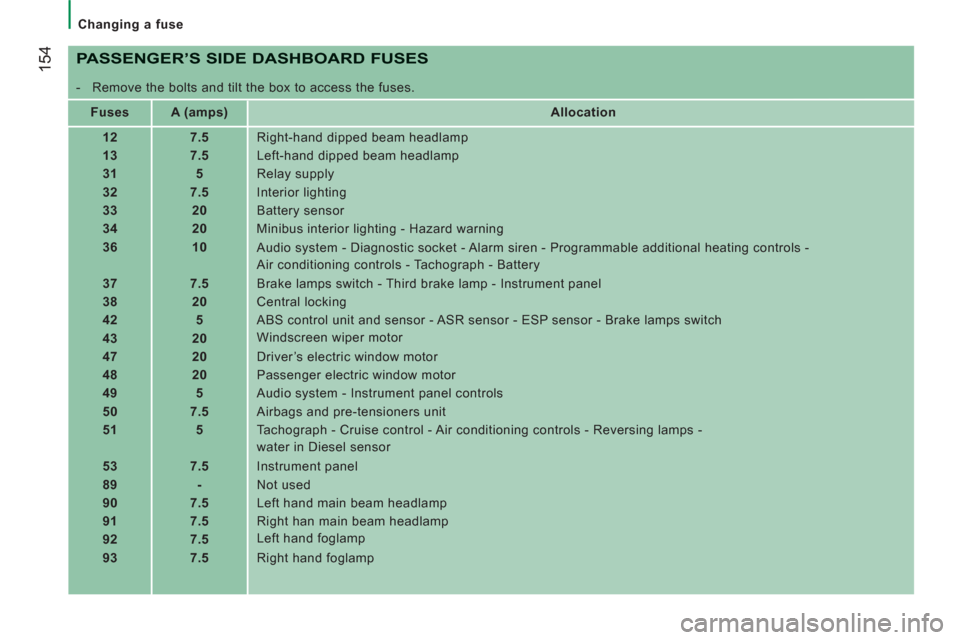
154
Changing a fuse
PASSENGER’S SIDE DASHBOARD FUSES
- Remove the bolts and tilt the box to access the fuses.
Fuses
A (amps)
Allocation
12
7.5
Right-hand dipped beam headlamp
13
7.5
Left-hand dipped beam headlamp
31
5
Relay supply
32
7.5
Interior lighting
33
20
Battery sensor
34
20
Minibus interior lighting - Hazard warning
36
10
Audio system - Diagnostic socket - Alarm siren - Programmable additional heating controls -
Air conditioning controls - Tachograph - Battery
37
7.5
Brake lamps switch - Third brake lamp - Instrument panel
38
20
Central locking
42
5
ABS control unit and sensor - ASR sensor - ESP sensor - Brake lamps switch
43
20
Windscreen wiper motor
47
20
Driver’s electric window motor
48
20
Passenger electric window motor
49
5
Audio system - Instrument panel controls
50
7.5
Airbags and pre-tensioners unit
51
5
Tachograph - Cruise control - Air conditioning controls - Reversing lamps -
water in Diesel sensor
53
7.5
Instrument panel
89
-
Not used
90
7.5
Left hand main beam headlamp
91
7.5
Right han main beam headlamp
92
7.5
Left hand foglamp
93
7.5
Right hand foglamp
Page 176 of 184
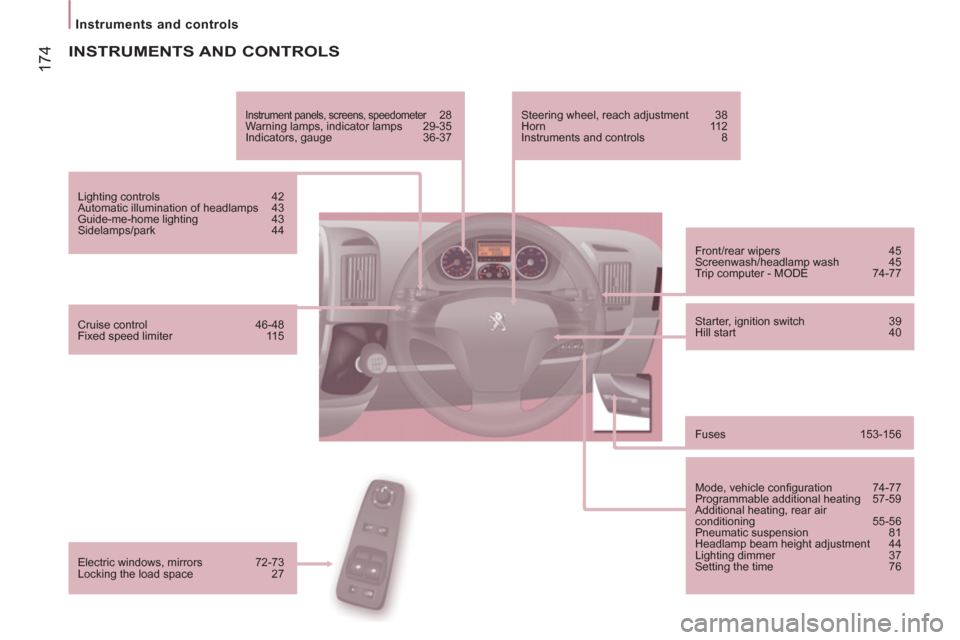
174
Instruments and controls
INSTRUMENTS AND CONTROLS
Instrument panels, screens, speedometer 28
Warning lamps, indicator lamps 29-35
Indicators, gauge 36-37
Lighting controls 42
Automatic illumination of headlamps 43
Guide-me-home lighting 43
Sidelamps/park 44
Fuses 153-156
Mode, vehicle confi guration 74-77
Programmable additional heating 57-59
Additional heating, rear air
conditioning 55-56
Pneumatic suspension 81
Headlamp beam height adjustment 44
Lighting dimmer 37
Setting the time 76 Front/rear wipers 45
Screenwash/headlamp wash 45
Trip computer - MODE 74-77
Starter, ignition switch 39
Hill start 40 Cruise control 46-48
Fixed speed limiter 115 Steering wheel, reach adjustment 38
Horn 112
Instruments and controls 8
Electric windows, mirrors 72-73
Locking the load space 27
Page 177 of 184
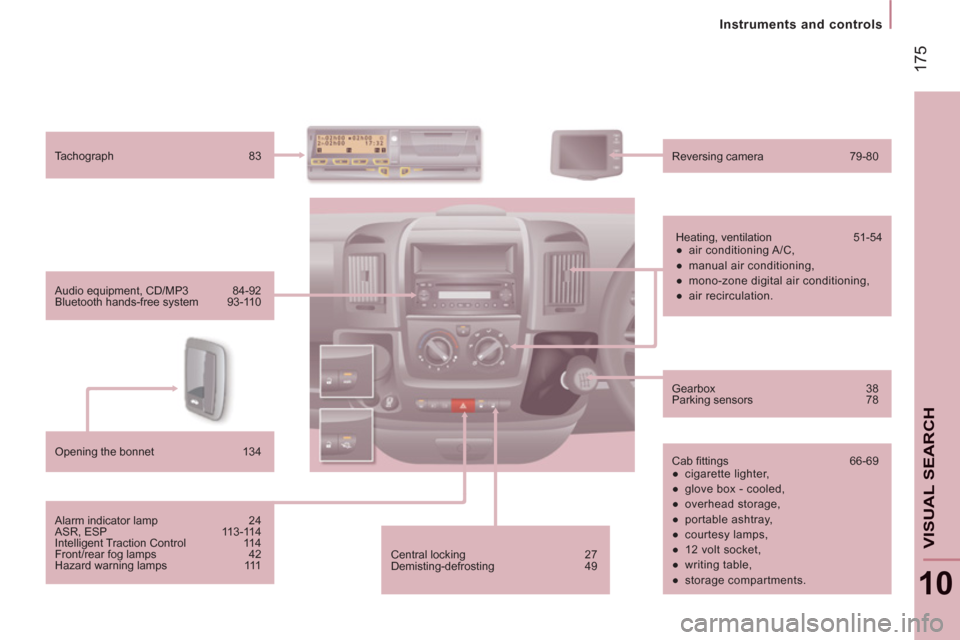
17
5
Instruments and controls
10
VISUAL SEARC
H
Central locking 27
Demisting-defrosting 49 Audio equipment, CD/MP3 84-92
Bluetooth hands-free system 93-110 Tachograph 83
Reversing camera 79-80
Heating, ventilation 51-54
●
air conditioning A/C,
●
manual air conditioning,
●
mono-zone digital air conditioning,
●
air recirculation.
Cab fi ttings 66-69
●
cigarette lighter,
●
glove box - cooled,
●
overhead storage,
●
portable ashtray,
●
courtesy lamps,
●
12 volt socket,
●
writing table,
●
storage compartments.
Gearbox 38
Parking sensors 78
Alarm indicator lamp 24
ASR, ESP 113-114
Intelligent Traction Control 114
Front/rear fog lamps 42
Hazard warning lamps 111 Opening the bonnet 134
Page 178 of 184
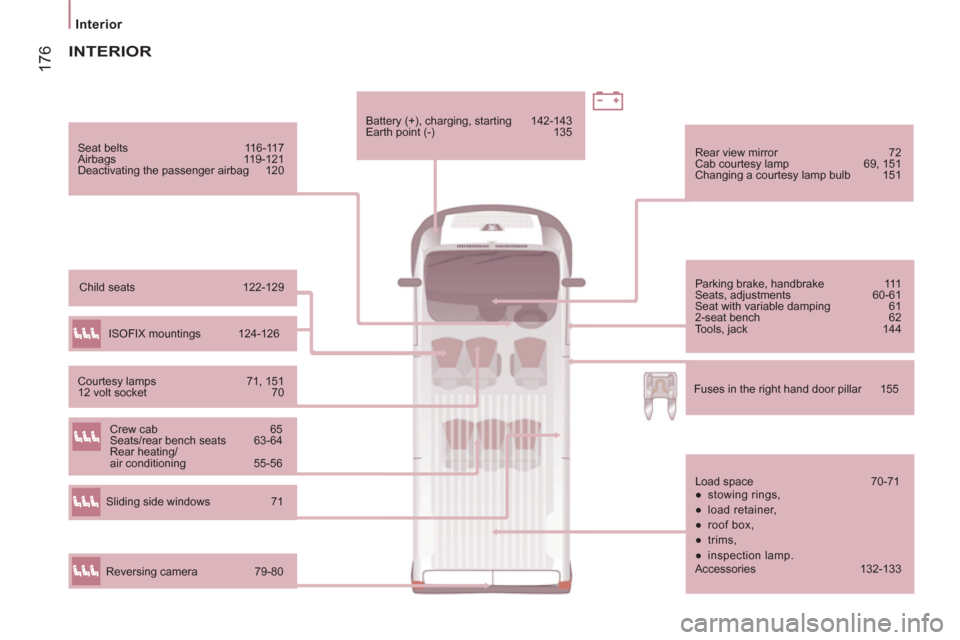
17
6
Interior
Seat belts 116-117
Airbags 119-121
Deactivating the passenger airbag 120
Parking brake, handbrake 111
Seats, adjustments 60-61
Seat with variable damping 61
2-seat bench 62
Tools, jack 144
ISOFIX mountings 124-126 Child seats 122-129
Courtesy lamps 71, 151
12 volt socket 70 Rear view mirror 72
Cab courtesy lamp 69, 151
Changing a courtesy lamp bulb 151
Load space 70-71
●
stowing rings,
●
load retainer,
●
roof box,
●
trims,
●
inspection lamp.
Accessories 132-133
INTERIOR
Sliding side windows 71 Battery (+), charging, starting 142-143
Earth point (-) 135
Reversing camera 79-80 Fuses in the right hand door pillar 155
Crew cab 65
Seats/rear bench seats 63-64
Rear heating/
air conditioning 55-56